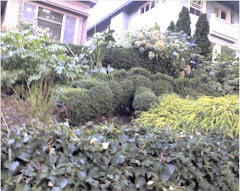I can relax for only so long and then I, too, need to find a project. I blame them.
When I realized that the one blank wall in the cabin needed to be painted, it became my project. Now, just painting the wall one color wasn't going to be enough for me. In fact, Ron is a painter by profession, so that would be a job he could easily do (almost with his eyes closed). I figured a mural would work beautifully.
It didn't take much, if anything, to convince Ron and Pat. I didn't even need to describe what I had in mind. I figured that this blind trust is partially a result of my teen years. I had my own bedroom and my parents allowed me to paint and paint again whatever I wanted on my walls. Since then I have painted several murals from the simple to the ornate.
 I wanted to do something simple for the cabin, yet something that echoed the surroundings outside. The result was this hazy hilly forest scene.
I wanted to do something simple for the cabin, yet something that echoed the surroundings outside. The result was this hazy hilly forest scene.The process is fairly easy. First Ron prepared the wall and painted the base coat using the lightest color. Starting with the next lightest color I painted the ground and trees in silhouette. Once that dried, I took the next slightly darker color and painted the next hill and tree silhouette
 slightly larger on top of the first. I repeated the process each time getting darker with the color. The fifth and final layer contains no trees, just ground and a bit of brush and grass.
slightly larger on top of the first. I repeated the process each time getting darker with the color. The fifth and final layer contains no trees, just ground and a bit of brush and grass.You can create a similar mural. (I know you can) You may want to sketch each layer or not depending on your confidence.To start select a paint chip at the store in the color that you want. There are often 4 or 5 colors on a chip that go from dark to light. Use them as your gradation. Use the lightest color as your base color and layer from there, lightest to darkest. If you want to be a little more daring you can chose colors from different chips within a color range. I used varying greens from light mint to olive to pine green to brown. They should still move from light to dark.
Try mountains, or rolling hills, or pine trees, or just tree trunks without the foliage. You can add as little or as much detail as you want. It is a nice, simple way to add depth and interest to a room without being too distracting. Have fun. It's only paint!
Be good,
Scott





1 comment:
Your website is amazing! Your mom and my mom sound like two peas in a pod. Maybe the not sitting still is a Midwest thing, I got the bug too.
Hope you are finding the Autumn here inspiring on your runs, I sure am.
I'll add you to my sites on my blog.
Take care
-k
Post a Comment